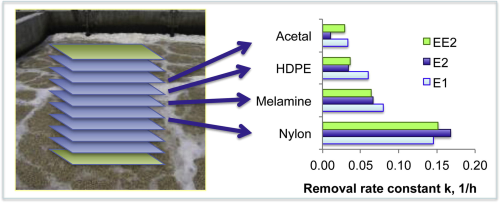
Submerged biofilm systems, such as integrated fixed-film activated sludge (IFAS) and moving bed bioreactors (MBBRs), are increasingly being used for domestic wastewater treatment, often to improve nitrification.
However, little is known about whether and how biofilm attachment surface chemical properties affect treatment performance. Surface chemistry is known to affect attachment in other systems, and work with pure strains has suggested that attachment of nitrifying bacteria may be enhanced on high surface energy surfaces.
To this end, researchers at the University of New Mexico and NM Department of Health systematically evaluated the effects of surface chemistry on biofilm quantity and rates of nitrification and estrogen removal.
Biofilms were grown on four plastic attachment surfaces with a range of hydrophobicity and surface energy values – nylon, melamine, high-density-polyethylene (HDPE), and acetal polymeric plastic – by immersing them in a full-scale nitrifying activated sludge wastewater treatment system, followed by batch test experiments.
Attachment surface hydrophilicity and surface energy were positively correlated with total biomass attachment, with more than twice as much biomass on the highest surface energy, most hydrophilic surface (nylon) than on the lowest surface energy, least hydrophilic surface (acetal plastic).
Absolute and specific nitrification rates were also correlated with hydrophilicity and surface energy (varying by factors of 5 and 2, respectively), as were absolute and specific removal first-order rate constants of the hormones estrone (E1), β-estradiol (E2), and 17α-ethynylestradiol (EE2).
These results suggest that attachment surface chemistry may be a useful design parameter to improve biofilm performance for the removal of ammonia and endocrine-disrupting hormones from wastewater.
Further research is required to verify these results at longer time scales and with typical media geometries.
Water Research, Volume 47, Issue 7, 1 May 2013, Pages 2190–2198.



